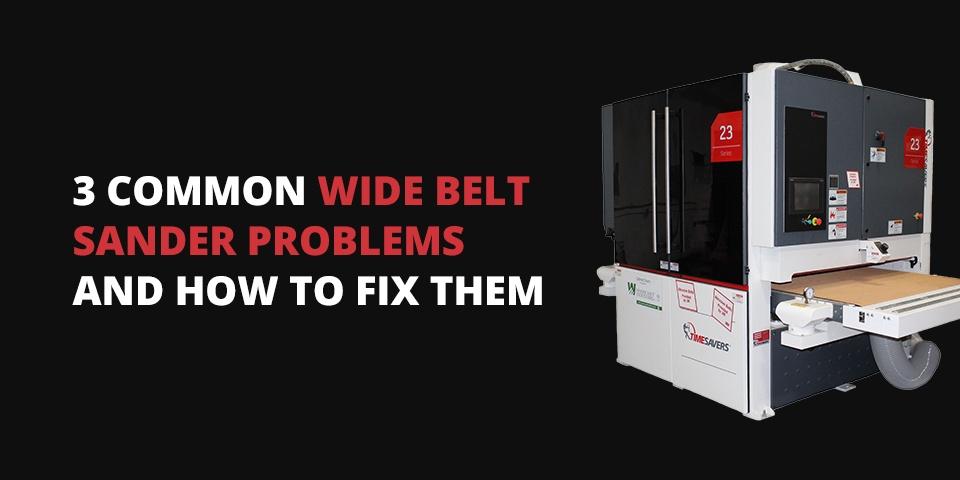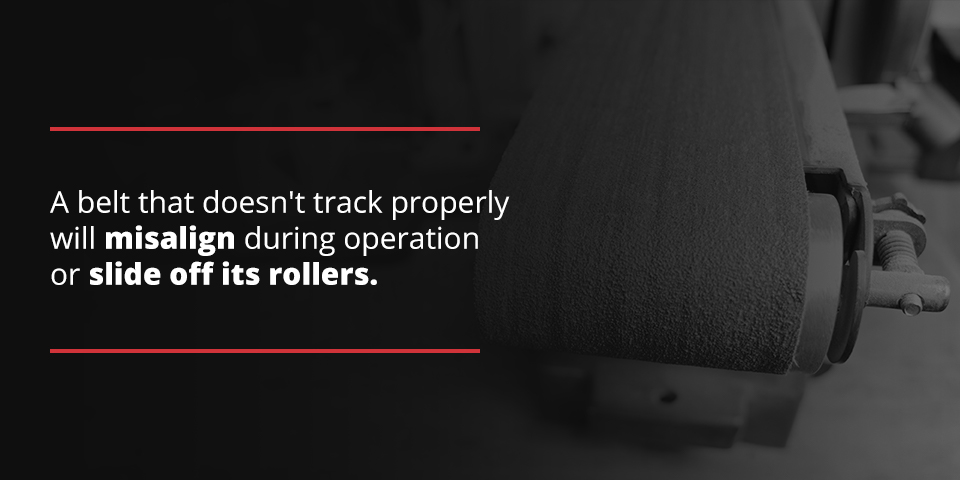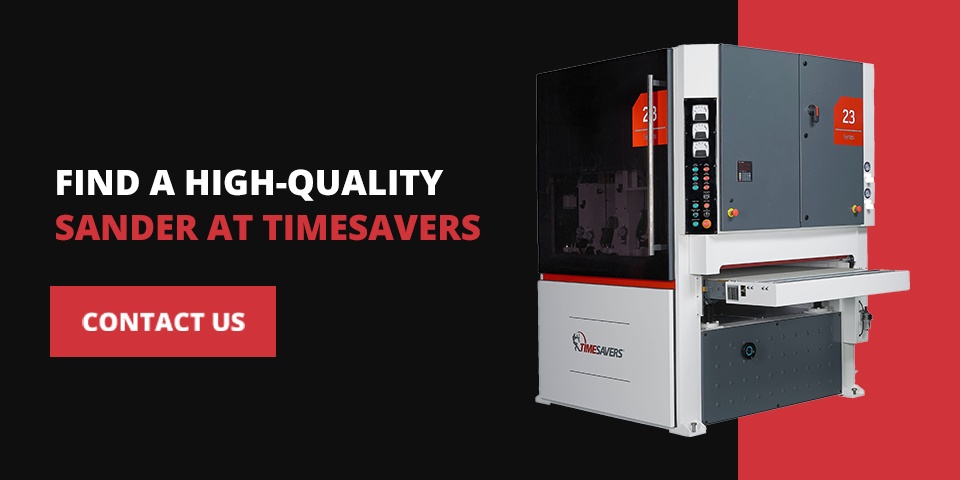3 Common Wide Belt Sander Problems and How to Fix Them

Table of Contents
- Damaged or Broken Belt
- Improper Belt Tracking
- Overloading or Belt Burning
- Find a High-Quality Sander at Timesavers
Although wide belt sanders are generally reliable machines, you’ll probably run into an issue while using one at one point or another. Whether it’s a problem with the belt or a visual defect in your workpiece, these problems are often easy to notice. However, isolating the root causes of these issues and fixing them can be much more difficult if you don’t have extensive knowledge of the machine.
Below, we’ll discuss several common wide belt sander problems and provide some tips on how to fix them and prevent them in the future:
1. Damaged or Broken Belt
If you’re constantly noticing frayed edges, tears or broken joints on sanding belts that are not near the end of their life span, there is probably something wrong. Some common causes of these issues include the following possibilities.
Excessive Loading
One of the most common causes for broken belts is excessive loading, which can result from foreign particles stuck in your machine or a workpiece that varies greatly in thickness. To prevent this, do the following:
- Clean the workpieces: Make sure they’re free of dirt and other debris before you run them through the sander.
- Ensure workpieces have the same thickness: Making sure they all have the same thickness will be much easier on your belt.
- Double-check the grit sequence: Make sure you’re using the correct one so your machine can run correctly.
Bad Belt Joints
Bad belt joints can be caused by various things, including faulty manufacturing, which makes the joint pop and separate when under pressure. However, the most common cause is simply normal wear and tear. Over time, belt joints become weak and break. To prevent your belt from breaking prematurely, check the recommended belt direction.
Belts often have joints that can work well in both directions, whereas others can only go in one direction. If the belt you use is unidirectional, ensure it is going in the recommended direction.
Damage During Storing, Packing or Shipping
To maintain a belt’s integrity, you must pack and unpack it carefully. When storing a belt, don’t put it on the floor, as this will cause it to absorb moisture. Instead, hang it up.
Improper Tracking
If your belt has not been tracking correctly on your machine, it will slide off its rollers or become misaligned during operation, which will likely lead to a tear. There are various causes of improper tracking, which we’ll cover in the following section on wide belt sander maintenance.
2. Improper Belt Tracking

A belt that doesn’t track properly will misalign during operation or slide off its rollers. Improper tracking can also lead to premature wearing or breaking of the belt. Improper tracking can result from various issues related to laser eye, belt cut, incorrect abrasive storage, uneven rollers or tension pressure.
Below, we’ll discuss each possible cause and show you how to perform wide belt sander troubleshooting:
- Obstructed laser eye: A blocked laser eye can lead to belt tracking issues. To fix and prevent this issue, wipe the eye to make sure it’s clean and dust-free.
- Improper tension pressure: Belt tracking problems can also be caused by improper tension — if the tension isn’t high enough, there will not be sufficient pull for the belt to stay in line. If the tension is excessively high, this can overwhelm the tracking cylinder. Always make sure the tension pressure is set to the value recommended by your manufacturer.
- Removal rate problems: If you’re continually experiencing belt tracking problems, this may also be because you’re trying to take too much material out in a single pass. Higher removal rates can dislodge the belt.
- Incorrectly cut belt: If your sanding belt wasn’t cut properly, this could also cause tracking issues. You can easily tell whether this has happened by visually inspecting the belt.
- Improper storage of abrasive material: As we mentioned above, belts can absorb moisture, which will cause them to change shape. For this reason, store your belts by hanging them. Don’t put them on the floor — especially if it’s concrete.
- Unparallel or uneven rollers: Improper belt tracking can also be caused by unparallel or uneven rollers. To determine whether your rollers are parallel, you can measure with a digital indicator and make adjustments accordingly. You can tell whether rollers are uneven by looking at them. If they are uneven, you will need to flatten or recoat them and then reinstall them.
3. Overloading or Belt Burning
Excessive loading means you will probably have to replace the belt frequently, which can quickly become costly. If there is excessive loading or your belt is burning and marking up your workpiece, there are likely process or technical problems you can address to solve the issue. We’ll discuss each of them below:
- Worn-out belt: The burning or high loading you’re experiencing could simply be because the belt is worn out. However, if your belt is wearing out prematurely, you likely have another problem on your hands.
- Removal rate problems: Removing too much material in a single pass can also cause burn or load problems. Each grit is designed to take out a certain amount at a time, and you should never skip more than one grit in a sequence.
- Incorrect abrasive storage: Again, when storing your belts, hang them so they won’t absorb moisture and lose their shape.
- Buildup of resin: Examine your workpieces to ensure they have no glue or resin accumulating on them before you run them through your machine. The glue or resin may melt onto your belt from the heat created by friction during the sanding. Accumulation on the belt may then cause burning and load problems.
- Sanding in one place: If you’re using the same entry point every time you sand, consider varying it more. Using the same place on your belt can wear down that part quickly.
- Inconsistent workpiece quality: If your workpieces aren’t dry or don’t have enough edge milling, this can lead to loading problems or burnt belts. Examine your workpieces before you put them in your sander to ensure the quality is consistent.
Find a High-Quality Sander at Timesavers
For over seven decades, Timesavers has been providing a wide variety of high-quality sanding machinery, including:
- Wide belt finish sanders
- Feed-through orbitals
- Abrasive planers
- Rough-lumber planers
- Seal sanders
- Brush sanders
- Molding sanders
- Veneer polishers
We also produce a variety of wet and dry metalworking machines, including finishing machinery, slag grinding machines, deburring machines and more.
Contact us to find a distributor near you!

